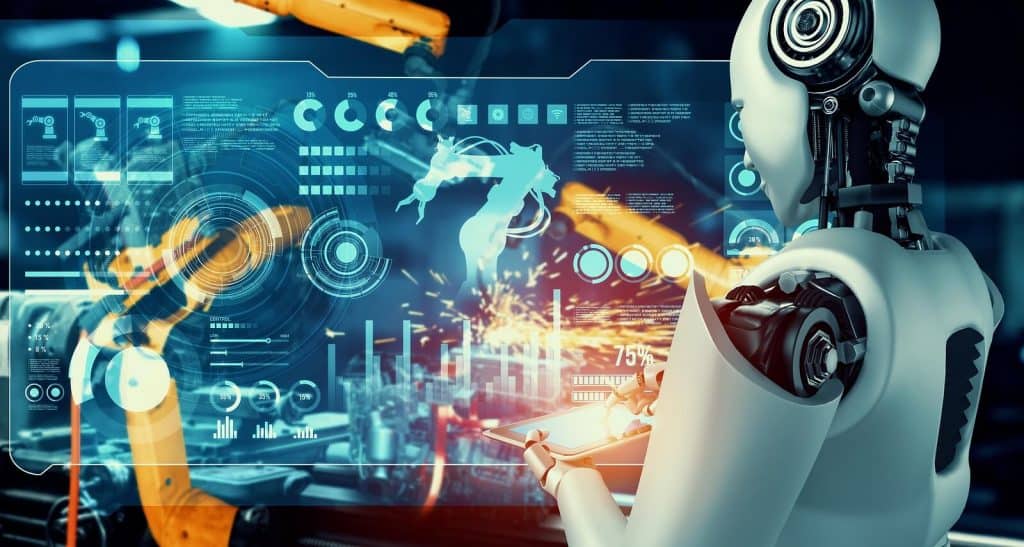The use of steam power paved the way for the first industrial revolution over 200 years ago. Modern manufacturing technology has come a long way since then. At the start of the 21st century, we now see ourselves amid the fourth industrial revolution. Also known as Industry 4.0, communication systems allow physical components to become one virtually. Of course, changing times make way for unprecedented capabilities. Here are five drivers of digitizing manufacturing and technologies to welcome a new era.
Table of Contents
Toggle5 Drivers of Digitizing Manufacturing
Robotics
Digitizing manufacturing processes combines the best of the virtual and material worlds. Cyber-physical systems integrate physical and computer components to improve how a process works. Using such a system results in more efficient and safer operations. A typical example of a cyber-physical system takes the form of robotics systems.
Robotics in manufacturing is a product of both computer science and engineering. A robot is a machine that is programmed to perform a specific task. Most manufacturing applications of robots involve labor-intensive, repetitive, or risky procedures. Typical use categories for robots include material handling, processing operations, or assembly and inspection.
Material handling refers to moving products around a facility.; processing operations include welding, spray painting, and automated machining; assembly and inspection procedures ensure that products meet a standard of quality. You will likely find robots to perform one or a combination of these purposes.
Robots in manufacturing already sound impressive as they are. But innovations continue to exceed limitations in an evolving world. For example, “lights-out” manufacturing is starting to become a reality using autonomous robots. FANUC, a Japanese robotics company, operates a manufacturing facility without human supervision for weeks at a time. Although without the innovation, creativity, and problem-solving skills of people on the plant floor, the operation will struggle to improve over time, such an operation does save on manual effort and electrical and HVAC resources.
3D Printing
Traditional ways of making parts involve subtractive processes. Fabrication starts with a piece of raw material, such as a block or a cast shape from a mold. The material is then machined to shave off unwanted parts. Eventually, the process ends with the final product. An example is using a lathe machine to turn a cylindrical metal piece into a standard bolt. These conventional techniques are effective, but they also generate large amounts of waste.
The idea of 3D printing is to take an additive approach. Instead of chipping away from a block, 3D printing builds by adding layers of material. This process leads to significantly less waste, as it only uses the required material quantity. Moreover, 3D printing no longer requires specialized tooling or conventional casting molds. It allows for a wide range of applications, even for complex and intricate designs.
The main limitations of 3D printing are the cost of a printer and limited printing materials. Yet, these are both starting to be addressed by recent innovations. The cost of a printer, for example, proves to be a sound investment when compared to more efficient material usage. A variety of printing materials has also become more available. Using plastic for rapid printing of prototypes remains to be a dominant application. But metal printing for end-use parts is becoming more common in manufacturing technology.
The Internet of Things
The defining development of Industry 4.0 is interconnectedness. The Internet of Things refers to how devices can communicate through the internet. In simpler terms, all equipment, sensors, machines, and other measuring devices can link together and exchange information.
This functionality allows managing teams to have an overview of the facility. Teams can now access a central data repository that allows for smart manufacturing. Sensors across a facility let teams know about the performance and condition of their equipment. It can capture specific information from instrument measurements, such as pressure and temperature readings. The analysis of these data points can then relate to whether or not corrective maintenance action is required.
More than gathering data, advanced systems also allow more proactive actions. All this is possible with the real-time flow of information between equipment. For example, sensors can expand from merely tracking historical data to predicting what can go next. Analyzing sensor data can make way for a condition-based or predictive maintenance approach.
Cybersecurity
With all the developing innovations in connectivity, cybersecurity standards need to keep up. For the most part, the average software user can count on their service provider for data privacy. But at the very least, consumers and companies should be aware of their rights to their data.
There are comprehensive privacy laws and regulations relating to cybersecurity. Laws generally require manufacturers to comply with standards set at the federal, state, or local level. Other security standards could be industry-mandated or volunteered as a service offering. Additionally, the National Institute of Standards and Technology (NIST) offers resources to assess and manage cybersecurity risk.
Ultimately, security issues – both physical and cyber – require risk management. The good news is that cybersecurity is in the spotlight as both a duty and a service for manufacturers. It helps to look into cybersecurity technologies, consider Cloud security as a service, and always remain informed.
Artificial Intelligence
Moore’s Law estimates that the speed and size of computers improve exponentially over time. The capability of computer systems today would have been unimaginable a few decades ago. We can now explore technologies that can crunch massive amounts of data in real-time. Concepts such as Artificial Intelligence (AI) are no longer just a futuristic sci-fi movie theme. It has now found its way to a promising innovation that would change manufacturing as we know it.
The concept of AI technology revolves around taking in data, analyzing patterns, and predicting what happens next. In manufacturing, practical applications include reducing material waste while increasing quality control. Imagine a system that can learn to detect the most subtle imperfections from a production line. Something that can take tremendous effort with lesser precision if done manually.
AI has also started to prove its usefulness in predictive maintenance. Sensors can collect real-time data from machines all over a facility. AI systems can then analyze the data and recognize any irregularities in a machine’s condition. A predictive maintenance strategy reduces unnecessary maintenance work while ensuring equipment reliability.
Conclusion
The future ofdigitizing manufacturing comes with drivers that will usher in a new era. Emerging technologies open the industry to a whole world of possibilities. The exciting part is that we are still in the middle of an emerging era. These developments are not showing any signs of slowing down, which tells us that there are more to come.




